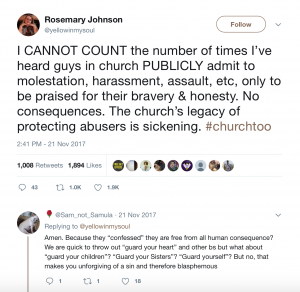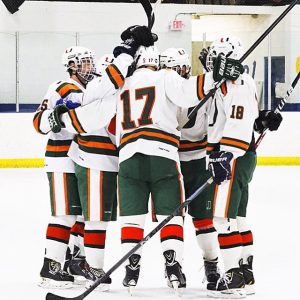By KATE JOHNSON
The #metoo movement has now inspired a new movement that is gaining traction called “#churchtoo.” The campaign was launched over Twitter by Hannah Paasch and Emily Joy, who are both survivors of sexual assault.
The mission of #churchtoo is to bring to light the rampant sexual abuse occurring in churches and among the Christian community.
Unlike the #metoo campaign, coverage of the #churchtoo movement has been very minor by secular news networks, if it is even covered at all.
However, the Huffington Post ran a lengthy online article written by Paasch. In her article, Paasch shared Joy’s story, told her own story and described the campaign.
Paasch wrote, “#ChurchToo is a platform not only where survivors can out their abusers — yes, names and all — but also where Christians, ex-evangelicals and agnostics alike can ask one another: How can we do better? What would a theology of consent and autonomy look like? How would we build a world in which that sort of church was not the exception?”
Time magazine was the only other well-known publication to run a story about #churchtoo. Their article was only a few short sentences and then a series of screenshots from fiery Twitter posts using the hashtag.

Many Christian publications have written about the campaign such at CBN, Relevant Magazine, and the Christian Post. All show support of the victims and are in favor of the campaign.
How the story of the campaign is told has varied greatly across Christian publications. I believe this is likely due to Paasch’s blatant criticisms of the Christian church.
Paasch fervently condemns what she calls, “purity culture” preached in churches and the widespread ideology of sexual restraint in the Christian community.
“That theology of abstinence that singles out women and slut shames everyone who engages in any kind of sexual activity outside of marriage. Purity culture is the religious antecedent to rape culture, as it lays the bulk of the responsibility for maintaining the sexual purity of both genders on women’s attire and behavior,” wrote Paasch in her article for the Huffington Post.
In her Huffington Post bio, she refers to herself as an “ex-Christian blogger.”
In CBN’s coverage of the #churchtoo campaign, Paasch’s name is not mentioned once. Instead, their coverage focuses on pastors and prominent Christian leaders who are advocating for churches to address the issues of sexual abuse.
CBN interviewed Jimmy Hinton, who is a pastor of Someset Church of Christ in Pennsylvania and consultant for the nonprofit GRACE on sexual abuse issues occurring in churches and faith-based groups.
Hinton reported his father, who had pastored the church for years, to the police. Hinton’s father confessed to multiple crimes against children and is now in jail, according to CBN News.
“Survivors are ready to fight for what’s right and they’re ready to fight to have their voice,” Hinton told CBN News.
CBN, a more conservative Christian network, did not quote any of the Twitter posts for the campaign or any survivor’s fiery condemnations of the Christian faith. Nor did CBN mention anything about “purity culture.”
Conversely, the Christian Post and Relevant Magazine, ran stories about the campaign where the majority of the text was direct quotes from survivors’ Twitters.
The Christian Post and Relevant Magazine both mentioned the oppression of women in churches and told the stories of people who have left the church as a result of sexual abuse.
This raises the question, is coverage of the #churchtoo campaign another way of suppressing the voices of victims?
In my opinion, the CBN story did not suppress the voices of survivor’s. They quoted prominent Christian U.S. gymnast, Rachael Denhollander, who was the first U.S. gymnast to publically accuse USA Gymnastics team doctor Larry Nassar.
“I pray you experience the soul-crushing weight of guilt so you may some day experience true repentance and true forgiveness from God, which you need far more than forgiveness from me, though I extend that to you as well,” Denhollander told Nassar in her impact statement in court.
I personally enjoyed reading CBN’s story about the campaign because it focused on church reform and the big strides being made to put an end to sexual abuse in the church and faith-based organizations. The CBN article did not dwell on the horrific crimes of the past, but rather spoke of optimism for the future.
 An image has been circulating on social media in which the words “thoughts & prayers” are crossed off and replaced by the words “policy & change.”
An image has been circulating on social media in which the words “thoughts & prayers” are crossed off and replaced by the words “policy & change.” Later during his formal speech, he also failed to mention gun control. Instead he continued to focus on mental health.
Later during his formal speech, he also failed to mention gun control. Instead he continued to focus on mental health.



 Yet, one week later Paul is posting videos on his Youtube channel of him tasering rats and joking about tide pod incidents that have sent many to the hospital.
Yet, one week later Paul is posting videos on his Youtube channel of him tasering rats and joking about tide pod incidents that have sent many to the hospital.


